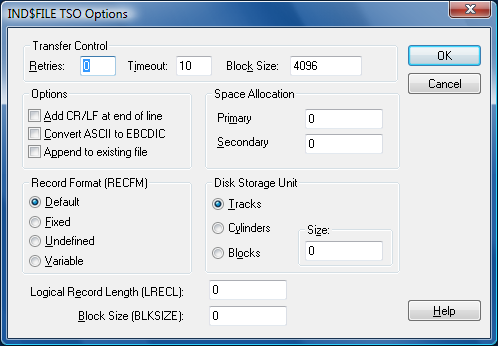IND$FILE File Transfer
You can use IND$FILE file transfer facilities using the IBM 3270 emulation connected to an IBM mainframe host.
IND$FILE – General Notes
IND$FILE is IBM’s file transfer protocol for transferring files between an IBM mainframe system and a Personal Computer. It is implemented in the form of host programs for CICS, for TSO and for VM:
-
5789-DQH CICS/VS 3270-PC File Transfer Program
-
5665-311 IBM 3270-PC File Transfer Program for TSO System
-
5664-281 IBM 3270-PC File Transfer Program for VM System
IND$FILE is two protocols:
-
A Block Mode protocol, which employs the 3270 Structured Field data stream. This can transfer up to 32K of data per transaction, vastly reducing the number of times the host has to switch processes and the number of network packets. This is the protocol of choice and will be employed by the host if possible. The main requirement is that the terminal supports extended data stream (see 3270 emulation).
-
An Async Mode protocol, which relies on screen images being sent. This can transfer less than 2K per transaction, causing a higher load on both the mainframe and the network. It also bears a number of additional overheads, which can reduce performance further, all of which increases the demands on the PC. CICS does not support this transfer mode.
IND$FILE can be started in one of two ways when using HostAccess:
-
From the command line, whether in TSO, CMS or CICS
-
From HostAccess’s menus.
Starting IND$FILE from the command line
While running a TN3270 emulation session, a user may type the IND$FILE command, complete with all required parameters. HostAccess will recognise that this has occurred when the mainframe starts the transfer. At this point, the user is prompted to enter the name of the PC file being sent or received.
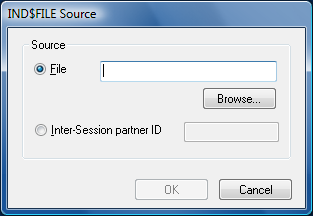
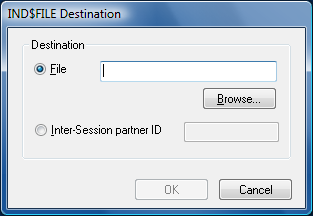
Starting IND$FILE from HostAccess menus
While running a 3270 emulation, the System|Start file transfer… menu option will initiate an IND$FILE transfer. This must be done while the cursor is at a command line. The user is prompted to identify the direction of transfer, the host system to which you are connected as well as the file name on the PC and the file name or dataset name on the host.
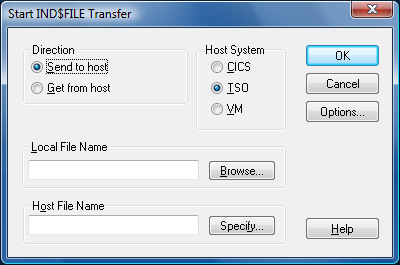
The Local File Name is the name of the file on your PC which you wish to send or receive. The Host File Name is the name of the file (CICS or VM) or dataset (TSO) on the mainframe.
Specifying the Host File Name
You can use the Specify… function to enter the Host File Name. For a CICS host, this can be up to eight letters or digits.
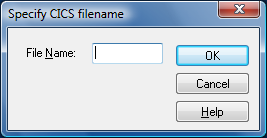
For a TSO host, the dataset name must be specified, either with or without quotes and the member name (for a partitioned dataset) and dataset password can be entered. If you enter a password, it will not be displayed at this point.
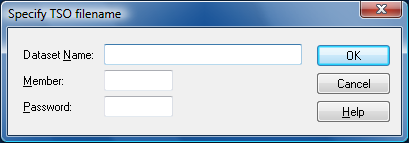
For a VM host, enter the name, type and mode of the file.

Advanced Options
When getting a file from the mainframe to your PC, whatever the system, you can specify:
-
The number of times which HostAccess should attempt to re-send data if an error is detected
-
A timeout period (in seconds) after which HostAccess may assume that the host program has failed
-
Whether to truncate spaces at the end of each line and insert a Carriage Return/Line Feed (CR/LF) pair.
-
Whether to convert the EBCDIC characters in the mainframe file to ASCII
These last two options are most typically used as a pair and are useful when transferring text files.
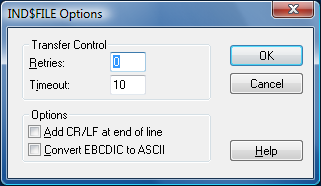
When sending a file to the mainframe, the options vary according to the host system. To a CICS system, the options above all apply (although CR/LF pairs are removed instead of added, and ASCII characters will be converted to EBCDIC instead of the other way around). In addition, the user can specify the block size to be used for the transfer. This only applies if the host agrees to use IBM’s Block Mode of transfer.
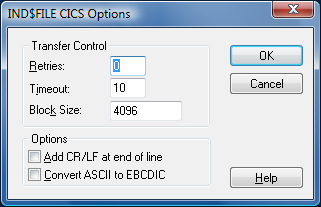
In addition to those options, a user connected to a VM system can specify:
-
Whether the data being sent will be appended to the name file, or will overwrite the file
-
The record format (RECFM) and record length (LRECL) of the file, if it has to be created.
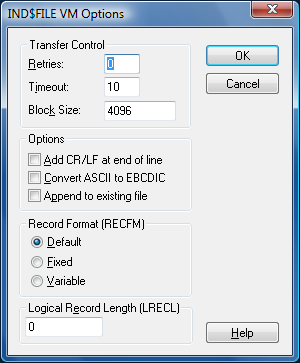
A user connected to TSO can specify any of the options available to a VM user, and can specify additional parameters when allocating a new dataset:
-
The physical block size to use on the mainframe
-
The space allocation quantities and units.
